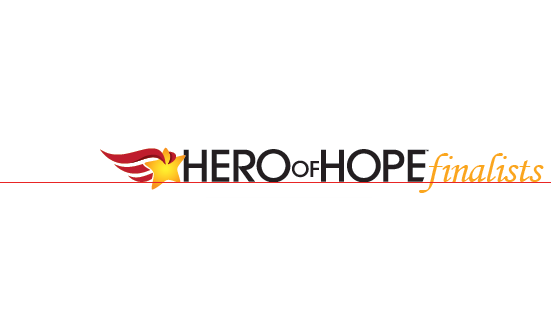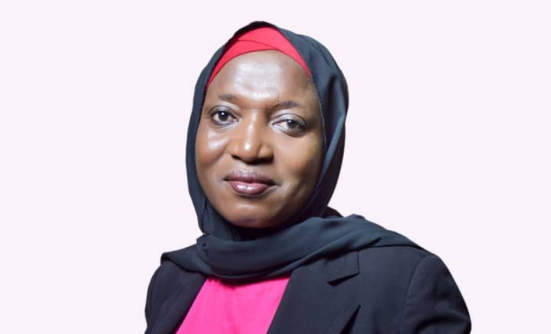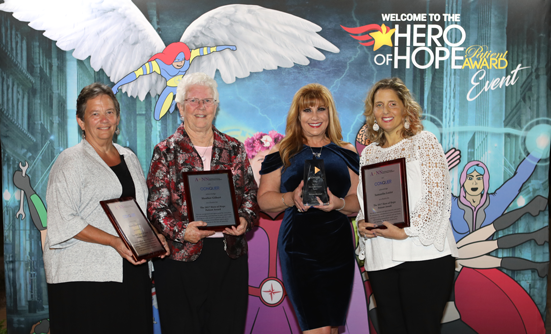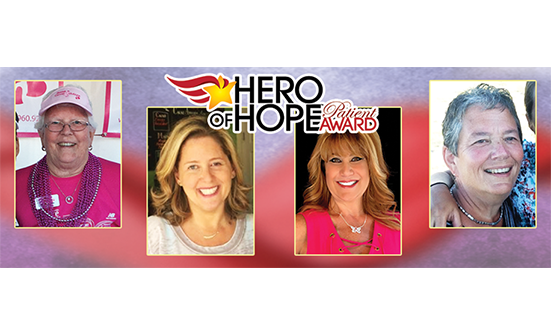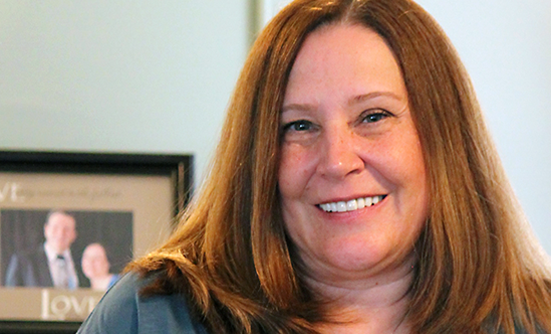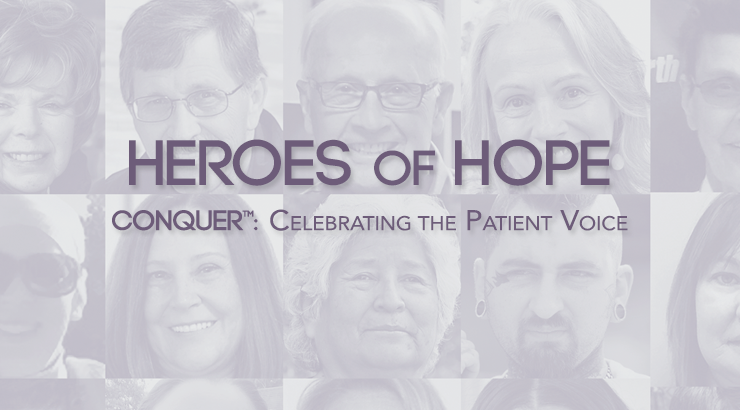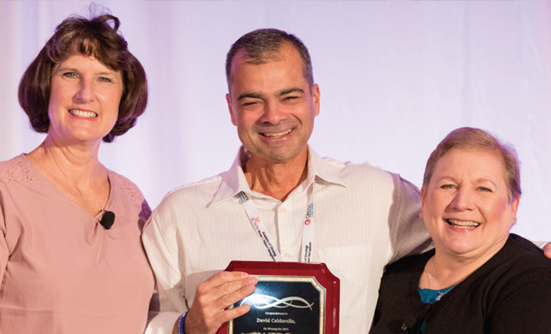The following 6 finalists were selected from the survivors you nominated for the Second Annual Hero of Hope™ Patient Award. These nominees were selected for their inspiring optimism and contributions to the cancer community in the face of adversity. The winner will be announced at the Seventh Annual Academy of Oncology Nurse & Patient Navigators Conference, November 17-20, in Las Vegas.
Overcoming Cultural Barriers in Cancer
Nellie Sandoval, Farmington, NM
For Navajo people, cancer is taboo, and many believe speaking about it can cause it. Cancer in Navajo is called “lóód doo nádziihii”—“the sore that does not heal.” These are the cultural barriers Nellie Sandoval has faced as a breast cancer survivor who grew up on a Navajo reservation in northwest New Mexico.
“My mom had breast cancer, so I was on the alert. I found a lump during a self-exam in 1989,” Nellie says. It was stage II breast cancer.
She had a lumpectomy and started aggressive chemotherapy and radiation; she met Frances Robinson, RN, OCN, a nurse navigator who would help her and become a lifelong friend. “I loved the way she treated me,” Nellie says.
In 1993, Nellie and another woman started a local women’s cancer support group through the American Cancer Society’s Reach to Recovery program. She quickly learned that many Navajo women were diagnosed in later stages, and dying in greater numbers, than other women. “I knew we had to do something to educate the reservation,” she says.
Together with the San Juan Medical Foundation, Nellie developed a video in Navajo on breast cancer. A 5-year grant from the National Cancer Institute helped to create a second video, featuring Native women with breast cancer. With her team, they created videos, seminars, and published materials on cultural matters in cancer—all these things have begun to change things for Navajo women.
“The women aren’t dying like they were; they just don’t,” Nellie says. “The women are becoming aware and knowledgeable. We still have some of the taboo, but they’re listening and doing something about it.”
Lymphoma STOMPs the Monster
Seth Grumet, Marlboro, NJ
Seth was training for his second Ironman Triathlon when he felt short of breath, which eventually led to a diagnosis of Hodgkin lymphoma. He had many unsuccessful treatments before an experimental drug reduced the cancer enough to allow for stem-cell transplant, and recovery.
Seth was fortunate to have an extensive support system, but he quickly realized not everyone was so lucky. “I met people during chemotherapy who needed rides to treatment, care for their families and children, even help paying their bills. All of these things were distracting them from what was most important—fighting their cancer,” he says.
Thus was born STOMP the Monster, a nonprofit organization for patients with cancer. The name was inspired by his daughter Maddy, who told him, “Your cancer is the monster under the floorboard. You just have to stomp it out!”
In 2015, STOMP the Monster provided nearly $400,000 to 810 patients with cancer. Since its inception, the organization has given $1.5 million in grant funds, which are raised through various fundraisers. “I’m especially proud that more than 90% of every dollar goes directly to assisting patients with cancer and their families,” Seth says. But the financial assistance pales in comparison to the peace of mind that STOMP the Monster affords patients.
“It’s about supporting them financially, but it’s also about bringing them joy again,” he says. “It makes a real impact when someone can stop worrying about life’s daily tasks and focus on getting better.”
Childhood Cancer Survivor and Motivational Speaker
Jearlean Taylor, Baltimore, MD
In Jearlean’s modeling photos you won’t see her ostomy bag, but that’s not because she’s hiding it. In fact, it’s one of the first things she tells about herself. She spent years building her confidence to share her story, which began when she was diagnosed at age 3 with a rare soft-tissue sarcoma called rhabdomyosarcoma. Jearlean received chemotherapy and radiation therapy and more than 12 surgeries, including urostomy and colostomy. Her parents were told she had a 50/50 chance of survival.
“I never grew up saying I wanted to be a model, but I’ve been modeling for 18 years now. At first I thought to myself, ‘modeling and ostomy bag, no way!’ But I decided to step out on faith and try it,” Jearlean says. She is also the owner of a modeling development company that works with aspiring models, starting at age 6, on all aspects of modeling.
“I was a pretty girl, but depressed and angry about my circumstances. Writing it down helped and gave me inner healing,” Jearlean says. This turned into her autobiography, Pretty Girl Blues, which she self-published in 2013. She cofounded a support group, Osto Beauties, for ostomates in Baltimore, and she regularly gives motivational speeches around the country to other ostomates, cancer survivors, church groups, youth mentoring groups, medical professionals, and women’s health organizations.
“I’m in awe of the blessings that have happened in my life, because I’ve told my story of overcoming cancer and living with an ostomy. I used to say, ‘Why me? Why cancer, why ostomy, why surgery?’ But now I say, ‘Why not me?’”
Fighting Cancer Is a Team Effort
Jerry Parins, Green Bay, WI
Throughout his storied career starting in 1965 as an officer with the Green Bay Police Department in Wisconsin and later with the Green Bay Packers, Jerry has protected and served the public and hundreds of patients with cancer.
In 1992 he retired and became Director of Corporate Security for the Packers, until 2003, when he was diagnosed with a rectal tumor roughly the size of a golf ball.
“I was devastated. My surgeon told me the tumor hadn’t established itself, and was between stages II and III, so I started the process of chemo and radiation right away,” Jerry said. He alternated chemotherapy and radiation for months before his surgery, and then more chemo.
He continued to work as much as he could, but “chemo brain” and fatigue often kept him away. Early in 2003, head coach Mike Sherman invited Jerry to meet with the team.
“I walk into this room, and the whole football team is there, they stood applauding me, and coach Sherman gives me an honorary game ball…I cried,” Jerry recalls.
Just 16 months after his diagnosis, Jerry and his friend Pat Doherty organized the first Jerry Parins Cruise for Cancer, which has since become an annual tradition with about 400 riders pledging to complete an 80-mile round trip ride. The first cruise raised $20,000 for cancer. The 13th annual cruise raised $95,000. Since 2004, they’ve raised more than $1 million.
“I get these letters from people who say how much the aid they received helps. When we make people smile for one day, it’s all worth it,” Jerry says.
Second Cancer and the Healing NET Foundation
Cindy Lovelace, Nashville, TN
In 2005, Cindy was diagnosed with breast cancer, a well-studied cancer. But her second cancer, diagnosed in 2011, was a rare and little understood cancer. A lung scan done to assess blood clots revealed a suspicious shadow in Cindy’s abdomen; after many tests, an endoscopic ultrasound showed a tumor on her neuroendocrine cells, leading to a diagnosis of a neuroendocrine tumor (NET). Surgery showed that the tumor was in the tail of the pancreas, which meant it could be removed by surgery.
When Cindy was diagnosed with the second cancer, she couldn’t find much information on NETs. After Steve Jobs died of NETs, Cindy searched again for information and found Dr. Eric Liu, a surgeon specializing in NETs. Dr. Liu was able to shed some light on Cindy’s condition. Using a new type of CT scan (called Ga-68-dotatate PET/CT) for diagnosing NETs, Dr. Liu found 2 tumors in Cindy’s liver that didn’t show on MRI. One of the tumors was removed, and now Cindy receives a monthly octreotide injection to control the growth of NETs in her liver.
In 2013, Cindy and Dr. Liu teamed up to launch the Healing NET Foundation (www.the healingnet.org), a nonprofit organization providing education and resources on NETs to physicians, while encouraging patients to connect their physicians to these resources.
“Other organizations are already doing great advocacy and fundraising. The void we need to fill is in educating front-line physicians,” Cindy says.
In 2016, the foundation held its first international summit, in partnership with the Association for Value-Based Cancer Care. “The goal was to bring together leading researchers and clinicians to examine how patients with NET are diagnosed and treated,” Cindy says.
When Cancer Runs in the Family
Maryann Wahmann
Maryann spent years trying to find the cause of her rectal bleeding, abdominal pain, and other gastrointestinal symptoms. Over 7 years, she had 7 colonoscopies, 7 endoscopies, and several wrong diagnoses before being diagnosed with carcinoid cancer, a type of neuroendocrine tumor (NET). The tumor was removed surgically, but she soon learned she would deal with NETs for the rest of her life.
“You can live 20 or 30 years, maybe more, with carcinoid syndrome, if it’s caught early enough,” she says. But early diagnosis is difficult, because the symptoms can be many conditions, such as irritable bowel syndrome or ulcerative colitis.
In 2002, Maryann and her husband helped grow a small support group to more than 100 patients with NETs. They also launched the nonprofit organization Neuroendocrine Cancer Awareness Network, which offers a carcinoid cancer hotline; organizes national and regional conferences; and hosts fundraisers, including an annual walk that was started by her daughter, Tricia.
“This year marks the 8th year for our annual walk on Long Island, and last year we started a virtual walk for people who wanted to participate but couldn’t get here,” she says. “We also host a ‘Celebration of Life’ gala in November for patients and their families.” To increase understanding of NETs, they established November as NET Cancer Awareness Month.
One of her greatest successes involves her daughter, who after many gastrointestinal symptoms and misdiagnoses was eventually, at Maryann’s request, screened for carcinoid cancer and was diagnosed with the disease.
“They found that carcinoid tumor 15 years before anyone else would have. I truly believe that my own diagnosis, the reason I do what I do, was to save my baby’s life,” Maryann says.





